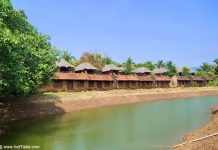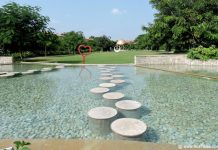Located on the northern banks of India’s and Asia’s largest brackish water lake Chilika, Mangalajodi village is a go-to destination for nature & Birding enthusiasts. The shallow marshy waters here are home to hundreds of thousands of Waterbirds, both migratory and local. You can take an organized boat ride here to sight and get a closer look at the diversity of birds this region hosts.

After visiting Bhitarkanika, on our 10 day Odisha trip, we were heading to Mangalajodi from Puri. Driving through the beautiful hinterlands, we took a quick tea break where the road connects to Bhubaneswar and Visakhapatnam or NH 16. Another twenty minutes or so of the drive to Chandpur town on the NH and then an 8 KMs drive through the village road takes you to the boating point. You can always inquire with villagers, en route on this stretch, for the boating point/jetty.

From Puri, it is about 75 km, mostly via the hinterland roads. From Bhubaneshwar, Mangalajodi is about 70 km but driving on the NH16. While you can save time on NH, the beauty of the hinterlands full of Ponds and greenery is what I recommend.

Waterbirds in Managalajodi Wetlands
Begin your journey by exploring the shallow brackish-water wetlands of this quaint village for a Birder’s delight.

We were pleasantly surprised with a line up of narrow long wooden boats with a canopy for shade, each named after a bird, at the jetty. Uniformed boatmen and guides with a smile on their faces welcomed the visitors heading for a boat ride. No haggling, no bargaining, pay the standard price as per the itineraries you wish to explore and get going.

These wetlands of the Mangalajodi area heaven for the waterbirds. These are the birds that find habitat in or around water – freshwater or brackish/marine waters. Some of their adaptations to wetlands include webbed feet, bills, and legs to feed in the water. Their primary source of food is fish, worms, insects, frogs, water snakes and so on that thrive in these wetlands. Finding their prey easily and naturally in the waters, they survive and thrive inhabiting these wetlands.

Best time for a Boat ride
You will find a lot of species of waterbirds here. The best time to visit for waterbirds sighting and photography is obviously early morning with the sunrise or an hour or so before sunset. Unfortunately, as we were driving from Puri and stopped en route to relish the farmlands, ponds along the way, and of course for a tea break.

Accordingly, we could do the Mangalajodi wetlands boat ride at around noon time for a couple of hours. They take you on a 2-3 KM by 1 KM area of the wetlands on the boat ride. Depending on your interest, small excursions, or halting/slowing down of the boat for better sighting, photography is part of the tour there.

Waterbirds at Mangalajodi

You will find a lot of variety of birds depending upon the time/season. Remember, some bird sightings always remain a matter of luck.

Commonly sighted birds in these wetlands are:
- Herons: Grey-Heron, Purple-Heron, Pond-Heron
- Egrets: Great-Egret, Intermediate-Egret, Little-Egret
- Kingfishers: White-throated Kingfisher, Common-Kingfisher, Pied-Kingfisher
- Ducks: Northern Pintails, Ruddy Shelducks, Lesser-Whistling Ducks, Common Pochards, Indian Spot-billed Duck
- Cormorants: Common-Cormorant, Indian-Cormorant
- Ibis: Glossy Ibis, Black-headed Ibis
- Bronze-winged Jacana
- Asian-Openbill Stork, Painted Stork
- Whiskered-Tern
- Citrine-Wagtails
- Ruff
- Red-wattled Lapwing
- Swallows
- Stork
- Black-winged Stilt
- Yellow Bittern

Other birds reportedly spotted in these wetlands include:
- Black-tailed Godwit
- Little bittern
- Little grebe
- Snipes
- Jacanas
- Robins
- Pipits
- Warblers
- Pied Mynahs
- Shoveller
- Cinnamon bittern

Wooden Boats to explore the Wetlands & Waterbirds
While boarding the small flat bottomed wooden boats, locally called Naukas or Dangas, we were like – no life-vests? ‘2 feet deep water Sir/Madam, don’t worry’ came the response with a smile. These boats are propelled by the boatman pushing against the shallow-water bed by a pole. much like punting. They are noiseless and perfect for exploring nature and waterbirds without causing any kind of disturbance.

About 4 adult tourists, a guide, and a boatman are all that the boat can carry. They move slowly and remember not to move around at your fancy/excitement. It can lose balance and water can splurge into the boat. If you want to change seats while boating, inform them, the boatman will find the nearest land to balance/support the boat, and then you can change seats.

You can do the basic boat ride in these wetlands on a day trip from Bhubhaneshwar or Puri. However, if you want to explore them in detail like a professional, it is better to stay overnight somewhere close by.

While it may look easy, the boatman’s job is skillful. The guys here are all well trained and were traditionally doing similar tasks earlier.

Do read: Birds of Pench National Park, Madhya Pradesh
Transformation of Mangalajodi
The villagers here, a couple of decades ago were the hunters of these very birds, for the last few years are the guarding these birds. Earlier that was their basic needs. There were hardly any professionally gainful employment options for them in those decades. Nature lovers, bird lovers, a day off the city visitors have changed the scenario here. The very hands that butchered the birds to make their ends meet, now hold Dr. Salim Ali’s handbook of Indian Birds. They guide and help identify the dozens of bird species. They point distant birds, explain their behavior, and tell the country of origin for migratory birds visiting these wetlands.

When you visit the place, you will appreciate their knowledge of the birds here. They are the guardians of the migratory and local birds of this wonderland. A lovely case of tourism helping to preserve the natural eco-system.
Boating at Mangalajodi
Several types of boat rides are available at the jetty. Some of them are day long and will take you to the deeper waters of Chilika lake serving on the boat cooked meals. We did a small 2-hour shallow water boat ride for the birding experience.

Winters or November to March is the best time to visit for bird sightings here. The shallow wetlands here are a significant global wetland habitat and international bird conservation area, heaven for waterbirds.
Do read: Beautiful birds of Chitwan National Park, Nepal
Punt Boat
In the western world, they call these kind boats Punt Boats. The technique of punting is to shove a boat along with a pole by pushing directly on the bed of the shallow waters. The ones you use here are pleasure punts and are lighter. It allows the boatman/punter to stand still towards the stern while shoving. Called “pricking” the punt, it has the advantage that more of the boat/punt can be used to carry passengers.

These small wooden boats about 12-18 feet long are bereft of keel, stern, ribs, and cabin. Their depth is about 2 feet only.
By the way, this village is well known for its boat makers. Wooden boatbuilding craftsmen, a hereditary profession, called Bindhani, Barhais, and Biswakarmas are based in this village. Though this is a dying profession for them. The shrinking Chililka lake over the decades and centuries has only worsened it.

Do read: 15 best places for birding in Goa you must explore
There is a Kiosk at the boating jetty where you can get Tea, Biscuits, and some minimalist snacks. The boat ride here takes about 2 hours and much more depending upon your choice. For the tourists, a proper meal in this village is available only at resorts on prior booking. Otherwise, you will have to drive 7-8 KMs to the nearest town for a basic meal. Plan accordingly if you are not staying overnight in the village.

Video of Mangalajodi wetlands boat ride
Take a look at this short video captured during our visit to the wetlands posted on the IndiTales YouTube channel. You can get a glimpse of the popular waterbirds heaven in Odisha if you plan a trip there.
Travel Tips
- Do carry drinking water on a boat ride. But don’t discard the plastic bottle in the natural body.
- A binocular is helpful to get a better view of the birds.
- For bird photography, a DSLR camera with a zoom lens would be helpful. Other zoom cameras take time to focus and moving boat adds to the difficulty in focusing.
- Do not feed the birds.
- Do not try to get off the boats in your enthusiasm for a closer look.
- The early morning boat ride though, best for bird sighting can be misty and therefore hazy. Reach the jetty by the time there is nice sunlight.
- There are a couple of resorts nearby in the village for those who wish to explore wetlands for a few days.
- You can do daily up and down trips from Bhubhaneshwar, but that may be quite a lot of traveling for the ones looking for a few day’s experience of this natural beauty.
- The boatmen and guides all are locals. They are experienced and knowledgable about the area you get to explore.













